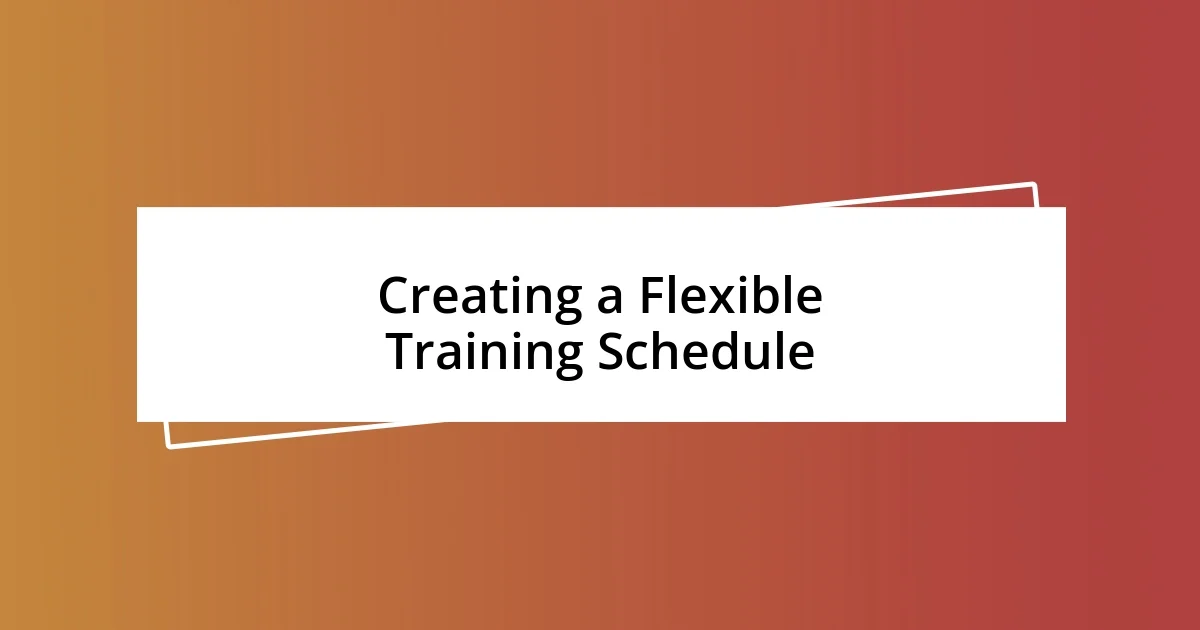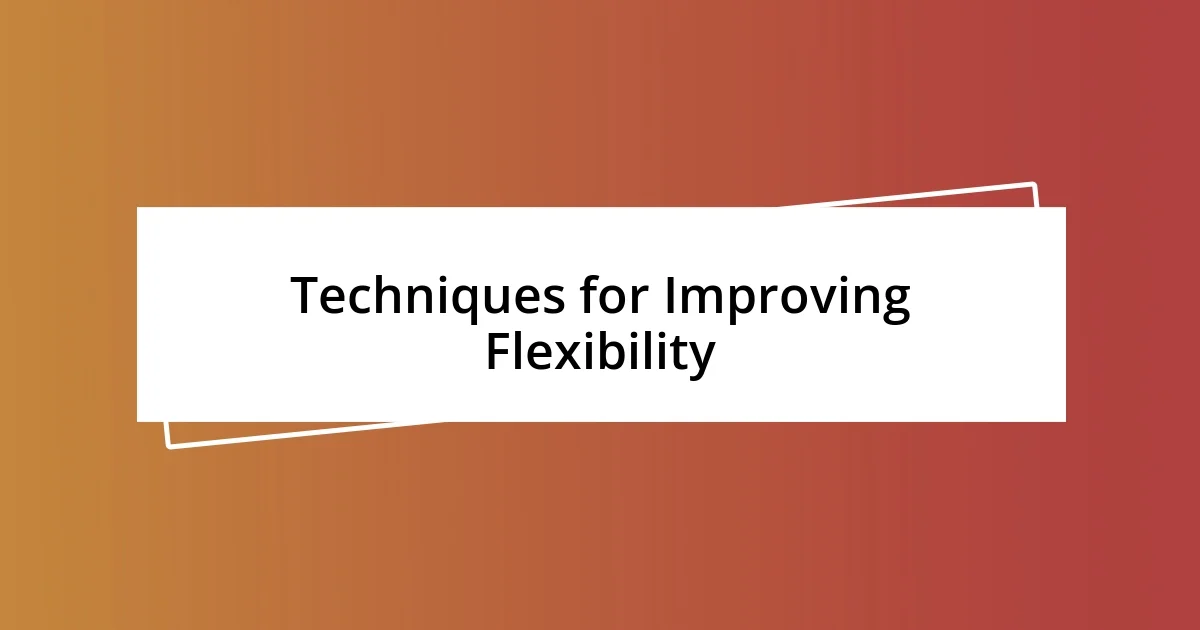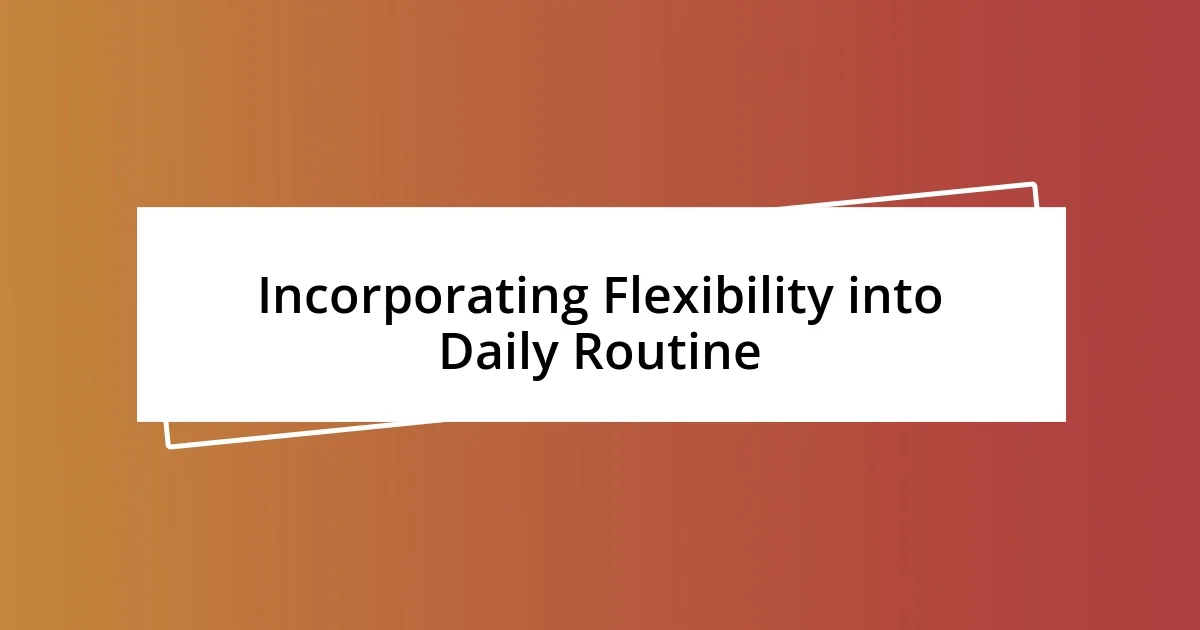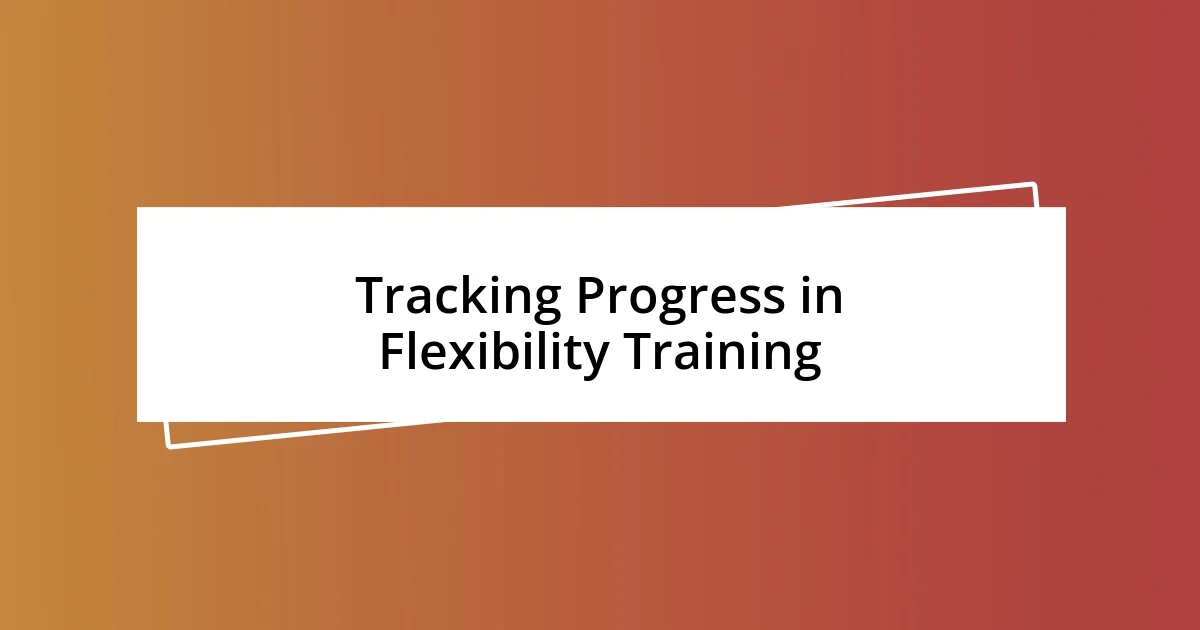Key takeaways:
- Flexibility training enhances physical performance, emotional well-being, and overall comfort, making it essential for fitness and relaxation.
- Choosing the right flexibility exercises is crucial; experimenting with methods like static, dynamic, and PNF stretching can lead to improved results and relief.
- Tracking progress through notes, photos, and apps can motivate and highlight improvements in flexibility training, while having a support system can boost morale and keep you accountable.

Understanding Flexibility Training Benefits
Flexibility training offers a myriad of benefits that extend beyond just stretching. I remember when I first struggled with tight hips after long days at my desk. Incorporating flexibility routines not only eased my discomfort but also improved my overall posture. Have you ever felt that tension after a workout? That’s often a sign that your muscles are tight and need some love!
One striking benefit of flexibility training is how it enhances your performance in other workouts. I started to notice that after dedicating time to flexibility exercises, my runs became smoother and my lifts felt stronger. Isn’t it fascinating how a few minutes of stretching can impact your strength and endurance?
Additionally, there’s an emotional aspect tied to flexibility training that often goes unnoticed. Each time I practiced yoga or dedicated time to stretching, I felt a wave of calm washing over me. It’s almost meditative. Have you ever experienced that release? This connection between body and mind not only alleviates physical tension but fosters a peaceful state of mind, allowing for greater overall well-being.

Choosing the Right Flexibility Exercises
Choosing the right flexibility exercises requires personal reflection on your body’s needs. For instance, I realized early on that static stretches worked wonders for me, particularly post-workout. If I skip stretching after a run, I can feel tightness creeping in, reminding me how important it is to honor my body’s signals. Have you found what works best for you?
The variety in flexibility exercises can often be overwhelming. When I first began, I felt lost among yoga poses and dynamic stretches. I discovered that incorporating a mix not only kept my routine exciting but also addressed different muscle groups effectively. Just the other day, I blended yoga stretches with foam rolling, and it was such a game changer! This combination seemed to unlock areas I didn’t even realize were tight.
In my experience, experimenting with different exercises has guided me in choosing the most effective methods for my flexibility journey. PNF stretching, for example, was initially foreign to me, but now I cherish its intensity and the immediate relief it brings. Discovering various techniques and paying attention to my body’s response has made all the difference in my overall flexibility. How do you approach finding the right exercises for yourself?
| Flexibility Exercise Type | Benefits |
|---|---|
| Static Stretching | Improves overall flexibility and muscle relaxation |
| Dynamic Stretching | Prepares the body for activity, increases blood flow |
| Yoga | Enhances balance, strength, and mental clarity |
| PNF Stretching | Achieves increased range of motion, very effective for rehabilitation |

Creating a Flexible Training Schedule
Creating a flexible training schedule truly transformed my approach to fitness. Initially, I was rigid, thinking I had to stick to a specific workout time every day. However, I realized that allowing myself some wiggle room made it easier to stay consistent. For example, on days when I had late meetings, I simply shifted my training to the morning. That little adjustment helped me maintain my routine without feeling overwhelmed. Have you considered how flexibility can ease your training stress?
- Assess your weekly commitments and identify ideal training windows.
- Incorporate shorter flexibility sessions into busy days, even if it’s just for 10 minutes.
- Listen to your body and adjust workouts based on energy levels and any discomfort.
- Utilize a planner or app to visually map out your training schedule for better organization.
- Be open to swapping workout days or times based on what feels right in the moment.
One of the best elements of a flexible training schedule is the freedom it offers. I find joy in mixing up my sessions based on how my body feels that day. Some days, I might crave an intense yoga flow, while on others, a leisurely stretch is all I need. By giving myself permission to be spontaneous, I’ve turned flexibility training into a more enjoyable experience. Have you ever felt the thrill of going with the flow instead of sticking to a strict routine?

Techniques for Improving Flexibility
When it comes to improving flexibility, I always recommend starting with static stretching. I remember one day after a grueling workout, I sat on the floor, leaning forward in a hamstring stretch. It took a moment to breathe deeply, but as I held that position, I felt the tension slowly dissolve. Have you ever noticed how just a single stretch can sometimes bring a wave of calm and release?
Incorporating dynamic stretching into my routine was another game changer. I often take time before a workout to do leg swings and arm circles, which not only prepares my muscles but also energizes me for the session ahead. It’s fascinating to see how these small movements increase blood flow and prime my body for action. Have you given dynamic stretches a shot before your workouts? The difference is palpable!
After experimenting with yoga, I found it to be more than just physical flexibility; it brought me emotional clarity too. I vividly recall one session where I struggled through a challenging pose. I kept falling out of it, feeling frustrated. But as I took a moment to breathe and refocus, I found balance—not just on the mat, but in my mind. That realization struck me: flexibility in body and mind go hand in hand. Have you experienced a similar revelation?

Incorporating Flexibility into Daily Routine
Finding moments throughout the day to incorporate flexibility training has become second nature for me. Whether it’s a quick stretch during a coffee break or a few minutes of yoga before bed, I’ve learned that even small pockets of movement can yield big benefits. Have you ever thought about how a brief pause for stretching might enhance your day?
I vividly recall a day when stress was peaking; I stepped away from my desk and performed shoulder rolls. Just a minute or two made a remarkable difference, melting away tension and helping me return with a clearer mind. It’s incredible how integrating just a few moments of flexibility work throughout my day can lead to increased productivity and less stress. Have you noticed a similar shift in your focus when you allow yourself a moment to breathe?
Employing reminders on my phone has also been a game changer. Setting alarms to remind myself to stretch goes a long way in keeping my body limber and avoiding stiffness from long hours of sitting. It’s like an invite to reconnect with my body amid the day’s chaos. Have you tried using technology to reinforce your goals? These little nudges can keep flexibility at the forefront of your routine.

Tracking Progress in Flexibility Training
Tracking my progress in flexibility training has been both enlightening and motivating. I began by taking simple notes after each session, jotting down how I felt and the ranges I achieved. It’s interesting how reflective writing can spotlight subtle improvements that I’d otherwise overlook. Have you ever recorded your own progress and felt a sense of achievement from small victories?
I also took photos to visually document my journey. Seeing side-by-side comparisons over weeks or months truly highlighted my growth, especially with tricky stretches like the splits. It filled me with pride every time I noticed an inch closer to my goal. Isn’t it amazing how a visual record can solidify the hard work we’ve put in?
Moreover, I discovered using a flexibility app that tracks my stretches and routines. Each time I checked off a completed session, it felt like a mini celebration. These small, consistent updates in the app not only kept me accountable but also fueled my desire to see the numbers improve. Have you considered using tech to help you visualize your progress? It brings a level of engagement that makes flexibility training even more enjoyable.

Overcoming Challenges in Flexibility Training
As I progressed in my flexibility training, I faced moments of frustration, especially when my body seemed to resist improvement. I remember one particularly challenging day when I tried to reach for my toes and felt as tight as a rubber band that just wouldn’t stretch. It made me question my commitment: Would I ever achieve the flexibility I desired? In those moments of doubt, I had to remind myself that growth often feels uncomfortable, yet it’s essential for progress. Have you experienced similar setbacks that made you wonder if your efforts were in vain?
In dealing with these challenges, I learned the importance of patience and listening to my body. Once, I pushed myself too hard during a stretching session and ended up with a strain that sidelined me for a week. That experience was humbling; it taught me to differentiate between discomfort from stretching and pain from overexertion. Now, I approach my training with a more intuitive mindset, considering how my body feels each day. Have you found a balance between pushing your limits and respecting your body’s needs?
I’ve also realized that having a support system can dramatically influence my journey in flexibility training. At times, sharing my struggles with a friend who also practices yoga helped alleviate my feelings of isolation. We would encourage each other, swapping tips and celebrating small victories—like finally nailing that tricky position we’ve both been working on. Isn’t it amazing how having someone by your side can make a challenging pursuit feel lighter? Such connections not only provide motivation but also remind me that I’m not alone on this path.














